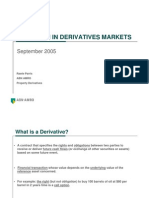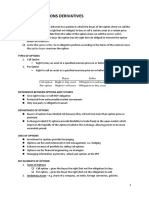The Black-Scholes Option Pricing Model (BSOPM) Has Been One of The Most Important Developments in Finance in The Last 50 Years
The Black-Scholes Option Pricing Model (BSOPM) Has Been One of The Most Important Developments in Finance in The Last 50 Years
Uploaded by
suganyababumbaCopyright:
Available Formats
The Black-Scholes Option Pricing Model (BSOPM) Has Been One of The Most Important Developments in Finance in The Last 50 Years
The Black-Scholes Option Pricing Model (BSOPM) Has Been One of The Most Important Developments in Finance in The Last 50 Years
Uploaded by
suganyababumbaOriginal Title
Copyright
Available Formats
Share this document
Did you find this document useful?
Is this content inappropriate?
Copyright:
Available Formats
The Black-Scholes Option Pricing Model (BSOPM) Has Been One of The Most Important Developments in Finance in The Last 50 Years
The Black-Scholes Option Pricing Model (BSOPM) Has Been One of The Most Important Developments in Finance in The Last 50 Years
Uploaded by
suganyababumbaCopyright:
Available Formats
1
Introduction
The Black-Scholes option pricing model
(BSOPM) has been one of the most
important developments in finance in the
last 50 years
Has provided a good understanding of what
options should sell for
Has made options more attractive to individual
and institutional investors
2
The Black-Scholes Option
Pricing Model
The model
Development and assumptions of the
model
Determinants of the option premium
Assumptions of the Black-Scholes model
Intuition into the Black-Scholes model
3
The Model
T d d
T
T R
K
S
d
d N Ke d SN C
RT
o
o
o
=
|
|
.
|
\
|
+ +
|
.
|
\
|
=
=
1 2
2
1
2 1
and
2
ln
where
) ( ) (
4
The Model (contd)
Variable definitions:
S = current stock price
K = option strike price
e = base of natural logarithms
R = riskless interest rate
T = time until option expiration
o = standard deviation (sigma) of returns on
the underlying security
ln = natural logarithm
N(d
1
) and
N(d
2
) = cumulative standard normal distribution
functions
5
Development and Assumptions
of the Model
Derivation from:
Physics
Mathematical short cuts
Arbitrage arguments
Fischer Black and Myron Scholes utilized
the physics heat transfer equation to
develop the BSOPM
6
Determinants of the Option
Premium
Striking price
Time until expiration
Stock price
Volatility
Dividends
Risk-free interest rate
7
Striking Price
The lower the striking price for a given
stock, the more the option should be worth
Because a call option lets you buy at a
predetermined striking price
8
Time Until Expiration
The longer the time until expiration, the
more the option is worth
The option premium increases for more distant
expirations for puts and calls
9
Stock Price
The higher the stock price, the more a given
call option is worth
A call option holder benefits from a rise in the
stock price
10
Volatility
The greater the price volatility, the more the
option is worth
The volatility estimate sigma cannot be directly
observed and must be estimated
Volatility plays a major role in determining time
value
11
Dividends
A company that pays a large dividend will
have a smaller option premium than a
company with a lower dividend, everything
else being equal
Listed options do not adjust for cash dividends
The stock price falls on the ex-dividend date
12
Risk-Free Interest Rate
The higher the risk-free interest rate, the
higher the option premium, everything else
being equal
A higher discount rate means that the call
premium must rise for the put/call parity
equation to hold
13
Assumptions of the Black-
Scholes Model
The stock pays no dividends during the
options life
European exercise style
Markets are efficient
No transaction costs
Interest rates remain constant
Prices are lognormally distributed
14
The Stock Pays no Dividends
During the Options Life
If you apply the BSOPM to two securities,
one with no dividends and the other with a
dividend yield, the model will predict the
same call premium
Robert Merton developed a simple extension to
the BSOPM to account for the payment of
dividends
15
The Stock Pays no Dividends
During the Options Life (contd)
The Robert Miller Option Pricing Model
T d d
T
T d R
K
S
d
d N Ke d SN e C
RT dT
o
o
o
=
|
|
.
|
\
|
+ +
|
.
|
\
|
=
=
*
1
*
2
2
*
1
*
2
*
1
*
and
2
ln
where
) ( ) (
16
European Exercise Style
A European option can only be exercised
on the expiration date
American options are more valuable than
European options
Few options are exercised early due to time
value
17
Markets Are Efficient
The BSOPM assumes informational
efficiency
People cannot predict the direction of the
market or of an individual stock
Put/call parity implies that you and everyone
else will agree on the option premium,
regardless of whether you are bullish or bearish
18
No Transaction Costs
There are no commissions and bid-ask
spreads
Not true
Causes slightly different actual option prices for
different market participants
19
Interest Rates Remain Constant
There is no real riskfree interest rate
Often the 30-day T-bill rate is used
Must look for ways to value options when the
parameters of the traditional BSOPM are
unknown or dynamic
20
Prices Are Lognormally
Distributed
The logarithms of the underlying security
prices are normally distributed
A reasonable assumption for most assets on
which options are available
21
Intuition Into the Black-Scholes
Model
The valuation equation has two parts
One gives a pseudo-probability weighted
expected stock price (an inflow)
One gives the time-value of money adjusted
expected payment at exercise (an outflow)
22
Intuition Into the Black-Scholes
Model (contd)
) (
1
d SN C =
) (
2
d N Ke
RT
Cash Inflow
Cash Outflow
23
Intuition Into the Black-Scholes
Model (contd)
The value of a call option is the difference
between the expected benefit from
acquiring the stock outright and paying the
exercise price on expiration day
24
Calculating Black-Scholes
Prices from Historical Data
To calculate the theoretical value of a call
option using the BSOPM, we need:
The stock price
The option striking price
The time until expiration
The riskless interest rate
The volatility of the stock
25
Problems Using the Black-
Scholes Model
Does not work well with options that are
deep-in-the-money or substantially out-of-
the-money
Produces biased values for very low or
very high volatility stocks
Increases as the time until expiration increases
May yield unreasonable values when an
option has only a few days of life remaining
You might also like
- Venture Capital PDFDocument94 pagesVenture Capital PDFRitu MehtaNo ratings yet
- Ezzahti, Ali - The Accuracy of The Black Scholes Model in Pricing AEX Index Call Options, Literature and Emperical StudyDocument35 pagesEzzahti, Ali - The Accuracy of The Black Scholes Model in Pricing AEX Index Call Options, Literature and Emperical StudyEdwin HauwertNo ratings yet
- Price Action Trading Introduction - Learn To TradeDocument8 pagesPrice Action Trading Introduction - Learn To Tradeimamitohm75% (4)
- BS Option Pricing Basics PDFDocument38 pagesBS Option Pricing Basics PDFPankaj Dayani100% (1)
- The Black-Scholes Merton ModelDocument8 pagesThe Black-Scholes Merton Modelsid pNo ratings yet
- Black ScholesDocument3 pagesBlack ScholesAditiNo ratings yet
- The Black-Scholes Option Pricing ModelDocument6 pagesThe Black-Scholes Option Pricing ModelDhruti BhatiaNo ratings yet
- Development of Algorithmic Volatility Trading Strategies For Equity OptionsDocument18 pagesDevelopment of Algorithmic Volatility Trading Strategies For Equity Optionsc0ldlimit8345No ratings yet
- BSMODELDocument20 pagesBSMODELkal74No ratings yet
- New Microsoft Office Word DocumentDocument16 pagesNew Microsoft Office Word Documentjyotisancheti070% (1)
- Derivative ABN AMRODocument22 pagesDerivative ABN AMROtcsdeepanshuNo ratings yet
- Derivatives ProblemsDocument85 pagesDerivatives ProblemsVijay KumarNo ratings yet
- Valuation: Packet 3 Real Options, Acquisition Valuation and Value EnhancementDocument157 pagesValuation: Packet 3 Real Options, Acquisition Valuation and Value EnhancementSandeep Kumar BNo ratings yet
- Soa University: Name: Gyanabrata Mohapatra Subject: Financial Derivetives AssignmentDocument10 pagesSoa University: Name: Gyanabrata Mohapatra Subject: Financial Derivetives Assignment87 gunjandasNo ratings yet
- Black-Scholes Option ValuationDocument13 pagesBlack-Scholes Option ValuationThanhMaiHoThiNo ratings yet
- Black & Scholes Model (FD)Document3 pagesBlack & Scholes Model (FD)Parul varshney100% (1)
- Chapter 5Document46 pagesChapter 5vaman kambleNo ratings yet
- Topic 4 BMS LiyaDocument24 pagesTopic 4 BMS LiyaLidia SamuelNo ratings yet
- Van Der Post H. Power Trader. Options Trading With Python 2024Document346 pagesVan Der Post H. Power Trader. Options Trading With Python 2024IDN3B GADGETS100% (1)
- Lesson - 5.1 International Finance ManagementDocument31 pagesLesson - 5.1 International Finance Managementashu1286No ratings yet
- Van Der Post H. Market Master. Trading With Python 2024Document336 pagesVan Der Post H. Market Master. Trading With Python 2024numl-s22-30115No ratings yet
- 12 Investment Under Uncertainty 2Document20 pages12 Investment Under Uncertainty 2jnfzNo ratings yet
- ch02 DerivativeDocument44 pagesch02 DerivativeFathy MohamedNo ratings yet
- Module 5Document13 pagesModule 5priyanka kanjilalNo ratings yet
- Chen Paper2 PDFDocument10 pagesChen Paper2 PDFAyush punjNo ratings yet
- JPMCredit Option Pricing ModelDocument8 pagesJPMCredit Option Pricing ModelsaikamathNo ratings yet
- EFB344 Lecture09, Options 2Document26 pagesEFB344 Lecture09, Options 2Tibet LoveNo ratings yet
- Czech University of Life SciencesDocument16 pagesCzech University of Life SciencesTrifan_DumitruNo ratings yet
- 07 Financial Option ContractsDocument20 pages07 Financial Option ContractsJyoti PaiNo ratings yet
- EFB344 Lecture08, Options 1Document39 pagesEFB344 Lecture08, Options 1Tibet LoveNo ratings yet
- Trading Hedging With OptionsDocument57 pagesTrading Hedging With OptionsShweta PingleNo ratings yet
- Butterfly Spread OptionDocument8 pagesButterfly Spread OptionVivek Singh RanaNo ratings yet
- Applications of Option Methods in Corporate FinanceDocument27 pagesApplications of Option Methods in Corporate FinancejayminashahNo ratings yet
- Volatility ProjectDocument29 pagesVolatility ProjectRatish CdnvNo ratings yet
- Derivatives: Analysis and ValuationDocument34 pagesDerivatives: Analysis and ValuationVanessa DavisNo ratings yet
- Chap 3 TCFDocument20 pagesChap 3 TCFMuhammad Umer SaigolNo ratings yet
- Options With PythonDocument203 pagesOptions With Pythonmahesh KumarNo ratings yet
- Chapter Seven Analysis of Derivative SecuritiesDocument25 pagesChapter Seven Analysis of Derivative Securitiesbiniyam zelekeNo ratings yet
- Option Pricing Theory and Applications: Aswath DamodaranDocument89 pagesOption Pricing Theory and Applications: Aswath DamodaranJairam PerumalNo ratings yet
- Maths Projecct For Fuck's SakeDocument11 pagesMaths Projecct For Fuck's SakeAyush SinghNo ratings yet
- FD - BS ModelDocument10 pagesFD - BS Modelmudassar.shirgarcivilNo ratings yet
- Options and Futures Lecture 4: The Black-Scholes ModelDocument18 pagesOptions and Futures Lecture 4: The Black-Scholes ModelMohanNo ratings yet
- Option Pricing - Black Scholes Merton - NMFDocument14 pagesOption Pricing - Black Scholes Merton - NMFISHANI PANDEYNo ratings yet
- Capital Markets and The Pricing of Risk: Chapter 10 (Part 2)Document66 pagesCapital Markets and The Pricing of Risk: Chapter 10 (Part 2)TaVuKieuNhiNo ratings yet
- Real Option For Policy AnalysisDocument10 pagesReal Option For Policy AnalysisEduardo FariasNo ratings yet
- Finsearch ReportDocument3 pagesFinsearch ReportTushaar JhamtaniNo ratings yet
- Options Pricing ModelsDocument3 pagesOptions Pricing ModelsGovarthanan NarasimhanNo ratings yet
- Lecture Note 07 - Fixed Income Options and Credit DerivativesDocument64 pagesLecture Note 07 - Fixed Income Options and Credit Derivativesben tenNo ratings yet
- SAPM Capital Asset Pricing ModelDocument27 pagesSAPM Capital Asset Pricing ModelSam RcostaNo ratings yet
- Black Scholes Model ReportDocument6 pagesBlack Scholes Model ReportminhalNo ratings yet
- Black Scholes ModellingDocument18 pagesBlack Scholes Modellings.archana100% (1)
- Module 4: Option PricingDocument62 pagesModule 4: Option PricingAbinash BiswalNo ratings yet
- How Do Derivatives Minimize Risks?: Involve Firm CommitmentsDocument19 pagesHow Do Derivatives Minimize Risks?: Involve Firm CommitmentssidwatereNo ratings yet
- Implied Volatility Step by Step GuideDocument22 pagesImplied Volatility Step by Step GuideAriol ZereNo ratings yet
- Basic Principles of Stock Options: © 2004 South-Western PublishingDocument45 pagesBasic Principles of Stock Options: © 2004 South-Western PublishingMohamed Sameh GameelNo ratings yet
- Maf 630 Chapter 8Document4 pagesMaf 630 Chapter 8Pablo EkskobaNo ratings yet
- Hedge Error Analysis in Black Scholes Option Pricing Model: An Asymptotic Approach Towards Finite DifferenceDocument12 pagesHedge Error Analysis in Black Scholes Option Pricing Model: An Asymptotic Approach Towards Finite DifferenceOBXONo ratings yet
- QF Illusions DynamicDocument4 pagesQF Illusions Dynamicpoojagopalia1162No ratings yet
- POITRAS EarlyExercisePremiumAmericanCurrencyOptionsDocument23 pagesPOITRAS EarlyExercisePremiumAmericanCurrencyOptionsLameuneNo ratings yet
- Van Der Post H. Python Fundamentals For Finance... Trading With Python 2024Document231 pagesVan Der Post H. Python Fundamentals For Finance... Trading With Python 2024Aina Horrach AlonsoNo ratings yet
- P VasumathiDocument4 pagesP Vasumathisuganyababumba100% (1)
- Implementing HRD ProgramsDocument36 pagesImplementing HRD Programssuganyababumba100% (1)
- Chap1me 130930231759 Phpapp02Document12 pagesChap1me 130930231759 Phpapp02suganyababumbaNo ratings yet
- HRD IntroDocument10 pagesHRD IntrosuganyababumbaNo ratings yet
- Using Information Systems To Compete: A Success Factor ProfileDocument41 pagesUsing Information Systems To Compete: A Success Factor ProfilesuganyababumbaNo ratings yet
- Pom Chapter 5Document103 pagesPom Chapter 5Patrice Elaine PillaNo ratings yet
- Highly Paid Ceo'S of India: "If You Can DREAM It, You Can DO It." - Walt DisneyDocument23 pagesHighly Paid Ceo'S of India: "If You Can DREAM It, You Can DO It." - Walt DisneysuganyababumbaNo ratings yet
- Money and Its FunctionsDocument20 pagesMoney and Its FunctionssuganyababumbaNo ratings yet
- Feasibility Study N Business PlanDocument22 pagesFeasibility Study N Business PlanPrerna ThakurNo ratings yet
- Char of HRMDocument3 pagesChar of HRMsuganyababumbaNo ratings yet
- Engineering As Social ExperimentationDocument30 pagesEngineering As Social ExperimentationsuganyababumbaNo ratings yet
- Egypt's Free Floating Exchange RegimeDocument13 pagesEgypt's Free Floating Exchange RegimeWalaa MahrousNo ratings yet
- 1 - M&a Course Manual - Part 1 - Company Valuation 4STDocument45 pages1 - M&a Course Manual - Part 1 - Company Valuation 4STachraflotfi49No ratings yet
- 006 - Chapter 6Document24 pages006 - Chapter 6male PampangaNo ratings yet
- International Capital Budgeting and Cost of CapitalDocument50 pagesInternational Capital Budgeting and Cost of CapitalGaurav Kumar100% (2)
- 33 11253 Fact SheetDocument2 pages33 11253 Fact SheetMuhammad YusufNo ratings yet
- BCGE Standard Settlement Instructions enDocument1 pageBCGE Standard Settlement Instructions enCarlos Alberto Chavez AznaranNo ratings yet
- Nse Eod 19.7.13 Gann LevelsDocument62 pagesNse Eod 19.7.13 Gann LevelsAjith Chand BhandaariNo ratings yet
- Acca f9 Notes j15Document202 pagesAcca f9 Notes j15opentuitionID100% (1)
- Ch05 Mini Case DisneyDocument8 pagesCh05 Mini Case DisneyRahil VermaNo ratings yet
- CPR PivotsDocument11 pagesCPR PivotsTanviNo ratings yet
- Answer:: ch07: Dealing With Foreign ExchangeDocument10 pagesAnswer:: ch07: Dealing With Foreign ExchangeTong Yuen ShunNo ratings yet
- National Pension SchemeDocument3 pagesNational Pension SchemeDIKSHA TIWARINo ratings yet
- Estimating Required Rate of ReturnDocument21 pagesEstimating Required Rate of ReturnSamiul21No ratings yet
- Content: Definition: Global Depository Receipt (GDR) Procedure For Issue of GDR in A CompanyDocument29 pagesContent: Definition: Global Depository Receipt (GDR) Procedure For Issue of GDR in A CompanyVirendra JhaNo ratings yet
- GSO V18 Sample PaperDocument21 pagesGSO V18 Sample Paperchetanraval826No ratings yet
- M9a-Mcq Set1 Aug2016Document14 pagesM9a-Mcq Set1 Aug2016abcsing0% (1)
- Managerial Finance Reviewer (Prelims)Document4 pagesManagerial Finance Reviewer (Prelims)Kendall JennerNo ratings yet
- Document Word TCSDocument9 pagesDocument Word TCSSUPREME GAMINGNo ratings yet
- Simple Trend-Following Strategies in Currency TradDocument3 pagesSimple Trend-Following Strategies in Currency TradAlwan AlkautsarNo ratings yet
- Finance Research TopicsDocument19 pagesFinance Research TopicsSamiuddin KhanNo ratings yet
- Financial Asset: Non-Financial AssetDocument2 pagesFinancial Asset: Non-Financial AssetNo NotreallyNo ratings yet
- StartupDocument18 pagesStartup401-030 B. Harika bcom regNo ratings yet
- Lecture Notes - IAS 33 (Diluted EPS)Document2 pagesLecture Notes - IAS 33 (Diluted EPS)Mazhar AzizNo ratings yet
- Indian Currency in Uae - Google SearchDocument2 pagesIndian Currency in Uae - Google SearchFATHIMA FATHIMANo ratings yet
- ACS - Acquisition of A 25% Stake in HochtiefDocument14 pagesACS - Acquisition of A 25% Stake in HochtiefCommodityNo ratings yet
- FX Volatility Smile Construction: Dimitri Reiswich Uwe WystupDocument12 pagesFX Volatility Smile Construction: Dimitri Reiswich Uwe Wystupfengw89No ratings yet
- FRM 2018 Lobs PDFDocument52 pagesFRM 2018 Lobs PDFAnonymous gtP37gHONo ratings yet
- Types and Sources of Financing For Start-Up Businesses: Ag Decision MakerDocument4 pagesTypes and Sources of Financing For Start-Up Businesses: Ag Decision MakerYeu MakanjeNo ratings yet




































































































